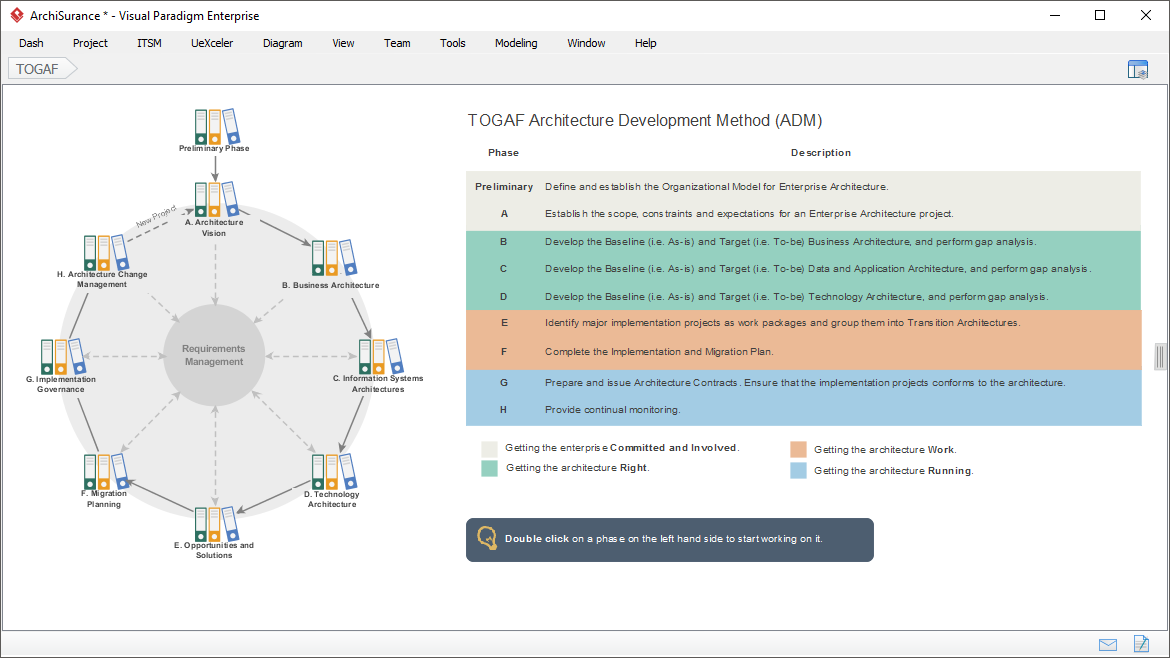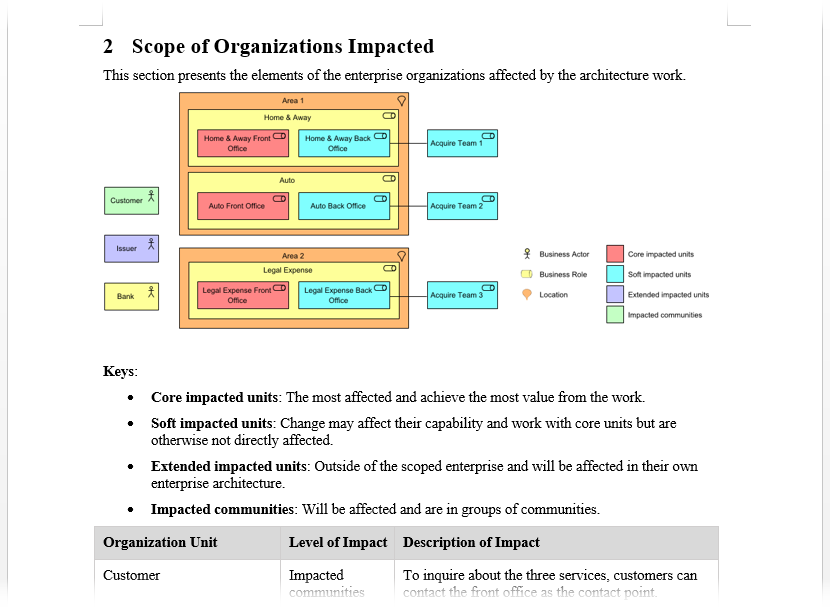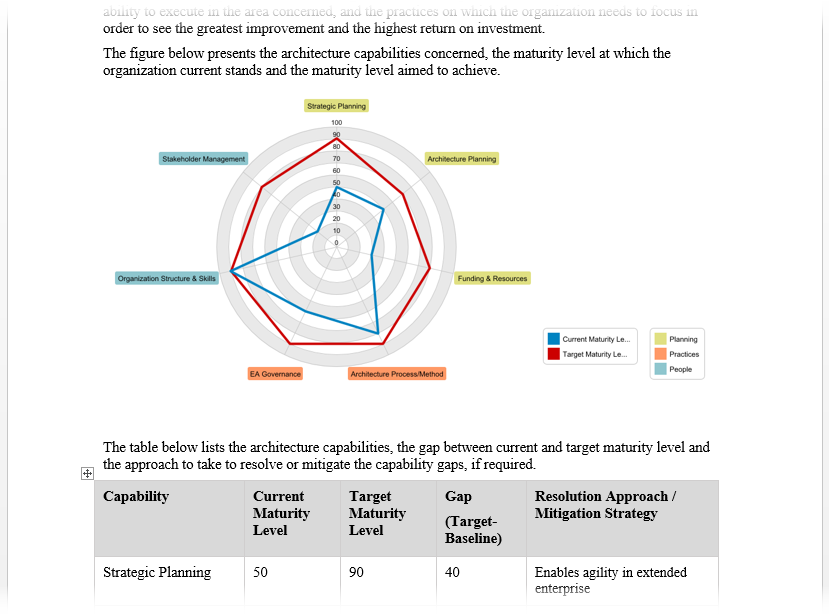TOGAF ADM: A Quick Tutorial
TOGAF ADM Overview
The TOGAF ADM is a foundational component of the TOGAF Standard, a time-tested and reliable framework that has been successfully employed by numerous enterprises over the years. Its primary objective is to guide the creation of an Enterprise Architecture that not only supports but also drives the realization of an organization’s vision and requirements. TOGAF 10, the latest version, provides comprehensive guidance on developing enterprise architecture that facilitates effective change.
What is the TOGAF ADM?
The TOGAF ADM represents a logical, systematic approach to acquiring knowledge necessary for enterprise architecture development. Each phase within the ADM outlines key activities and information inputs essential for knowledge creation in the pursuit of enterprise architecture. The beauty of the TOGAF ADM lies in its universality—it adapts to the development of enterprise architecture at various levels of detail, spanning from strategic planning and portfolio management to project implementation and solution delivery.
Crucially, the ADM is inherently incremental and iterative in nature, leveraging existing architecture and TOGAF Foundation Architecture elements. While it is often depicted graphically, it is not a rigid, linear sequence of steps. It’s essential to grasp that each time the enterprise architecture team undertakes an activity associated with an ADM phase, they are essentially executing that specific phase, adhering to mandatory inputs and producing required outputs. This principle applies consistently across all ADM phases.
Utilizing the TOGAF ADM as an information model empowers enterprise architects to maximize efficiency and productivity, ensuring a streamlined approach to architecture development.
TOGAF ADM Phases
The Architecture Development Method (ADM) comprises nine distinct phases, each dedicated to specific roles and comprehensively describing essential aspects. These phases encompass the identification and understanding of objectives, input requirements, necessary steps, and expected outputs. Adhering to these phases is crucial for unlocking the full potential of TOGAF ADM.
TOGAF ADM Phases Explained
In this section, we will provide in-depth explanations of the TOGAF ADM Phases, focusing on establishing and developing enterprise architecture.
Preliminary Phase – Framework and Principles The Preliminary Phase serves as an introduction, designed to set the stage for the enterprise architecture team. It revolves around addressing key questions and issues that the team must grapple with, including target stakeholders, application scenarios, usage guidelines, and the rationale for adopting the model. By comprehending the Preliminary Phase, you gain the ability to:
- Define an organization or enterprise.
- Identify and comprehend principal elements and critical drivers within the enterprise.
- Describe the requirements for architecture work.
- Define the principles that impact architecture work.
- Identify the most suitable framework for the organization.
- Establish connections between different management frameworks.
- Evaluate the maturity of the enterprise architecture team.
TOGAF ADM Phases Explained In this section, we will delve into the TOGAF ADM Phases dedicated to crafting a successful enterprise architecture.

Phase A: Defining Architecture Vision Every architecture development journey commences with Phase A. Without the foundation laid in Phase A, an enterprise architect cannot confidently address the right challenges, constraints, and stakeholders. The phase begins with the concept of a Request for Architecture Work, encompassing crucial activities such as defining the architecture scope, identifying stakeholders and their concerns, and acknowledging constraints imposed by higher-level architectures. Ultimately, Phase A culminates in the creation of an architecture vision—a concise summary of one or more potential target architectures. If any of these candidate architectures demonstrate the potential for significant improvement with a reasonable amount of effort, the team is equipped to proceed. The final step involves securing approvals to proceed with the development of the enterprise architecture.
It is essential to recognize that the absence of a suitable architecture vision can lead to a valuable outcome—the decision to halt architecture development if stakeholders cannot envision sufficient value. In this case, the enterprise architecture team saves precious organizational resources from being misallocated.
Phase A represents the cornerstone of the TOGAF ADM, ensuring that architecture development remains aligned with the organization’s goals and requirements. It emphasizes the importance of rigorous planning and vision setting as the initial step in the journey.
Phase A – Start at the Beginning with an Architecture Vision This section explores Phase A deliverables, the role of Architecture Governance, and offers guidance and techniques specific to Phase A.
Phase B: Developing the Business Architecture Phase B centers on the development of the business architecture domain, focusing on the current state of the business structure and the intended goals of stakeholders. Key activities involve organizational design, enterprise processes, information flows, business capabilities, and strategic business planning. A thorough understanding of this phase is vital to crafting a robust business architecture.
Phase C: Developing Information Systems Architectures Building upon the insights gained in Phase B and the enterprise’s enhanced understanding, Phase C takes the next critical step—developing Information Systems Architecture. This phase involves a detailed exploration of both the Data Architecture Domain and the Application Architecture Domain.
Phase D: Describing and Developing Technology Architecture Phase D is dedicated to the identification, description, and development of Technology Architecture. It encompasses various tasks, such as identifying viewpoints, goals, reference models, and tools, creating Baseline Technology Architecture, defining Target Technology Architecture, performing gap analysis, outlining roadmap elements, addressing Architecture Landscape effects, engaging in stakeholder reviews, finalizing Technology Architecture, and generating the Architecture Definition Document.
Phase E: Identifying Opportunities and Solutions Phase E revolves around identifying opportunities and seeking optimal solutions to address both current and previous challenges. This phase entails the identification of key phases, determination of change parameters, assessment of top-level projects, and more.
Phase F: Crafting a Migration Plan A well-crafted migration plan is essential for ensuring a smooth transition. It encompasses all critical elements and outlines the mode of implementation according to priority. Activities within this phase include cost assessment, benefits analysis, dependency evaluation, and more.
Phase F – Craft the Implementation Plan This section discusses Phase F Implementation Plan Deliverables, Implementation Plan techniques, and Phase F tools.
Phase G: Governance Implementation The Implementation Governance phase focuses on executing the changes outlined in the Architecture Roadmap and Implementation Plan. It also incorporates valuable insights from other implementation projects. Effective architecture governance plays a pivotal role in managing projects successfully while mitigating risks.
Phase H: Establishing Architecture Change Management Architecture Change Management is vital in ensuring that the anticipated benefits of the target enterprise architecture are realized. This phase ensures that the target architecture remains aligned with the organization’s evolving circumstances and ecosystem. It defines key attributes, the target state, and the management approach, working in conjunction with the Architecture Requirements Management process and maintaining continuity.
TOGAF Phase H – Applying Agile and Real-World Enterprise Agility This section explores Phase H in depth, providing insights into its Agile application and offering a webinar resource for a real-world perspective on Enterprise Agility led by experienced enterprise architects.
Are you ready to take your enterprise architecture game to the next level? Visual Paradigm’s TOGAF ADM Guide-Through Process Tools are here to empower your organization’s architecture development like never before. Let’s dive into how Visual Paradigm can be your trusted companion throughout the TOGAF ADM phases:
Visual Paradigm’s TOGAF Guide-Through Process Tool
Unlock Your TOGAF ADM Journey with Visual Paradigm’s Guide-Through Process Tools!

🏆 Comprehensive Guidance: Visual Paradigm’s guide-through process tools align perfectly with the TOGAF ADM framework. Whether you’re in the Preliminary Phase or navigating the intricacies of Phase H, our tools provide comprehensive guidance at every step.

🧭 Seamless Navigation: No need to get lost in the complexity of enterprise architecture. Our user-friendly interface ensures you navigate through the TOGAF ADM phases effortlessly, allowing you to focus on the architecture itself rather than the process.
🛠️ Practical Implementation: Visual Paradigm’s tools don’t just stop at theory; they help you put your architectural plans into action. Craft robust Business Architectures, develop Information Systems Architectures, and describe Technology Architectures with practicality in mind.

🚀 Streamlined Transition: Transitioning from one phase to the next has never been smoother. Visual Paradigm aids you in identifying opportunities, crafting migration plans, implementing governance, and establishing change management, ensuring a seamless transition to the next stage of your architecture journey.
📈 Maximize Efficiency: Visual Paradigm empowers your enterprise architects to achieve maximum efficiency and productivity by serving as a comprehensive information model. Say goodbye to inefficiencies and welcome a streamlined approach to architecture development.
📢 Ready to embark on a successful TOGAF ADM journey? Don’t miss out on the opportunity to elevate your enterprise architecture game with Visual Paradigm’s Guide-Through Process Tools. Join the ranks of successful organizations that have harnessed the power of TOGAF ADM with Visual Paradigm today!
🌐 Visit Visual Paradigm to explore our TOGAF ADM Guide-Through Process Tools and start transforming your enterprise architecture with confidence! 🌐

